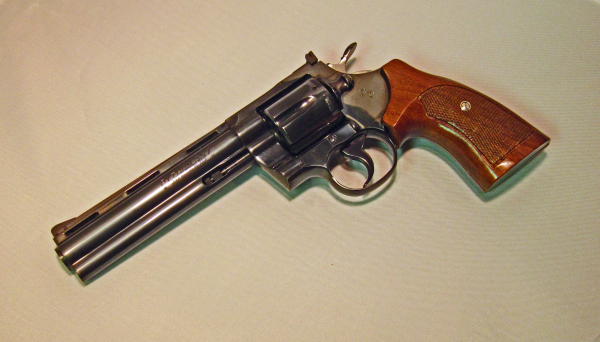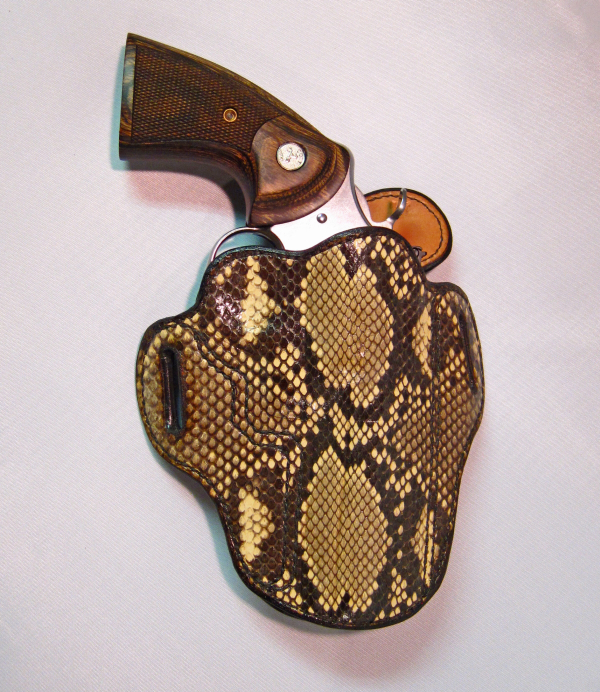
Based on recent events, it seemed time to look back at the Colt Python. A grand old design, there’s been a lot written about it. It’s easy to find sources, really good stories written by a range of gun journalists like Rick Hacker, Dave Campbell, Wiley Clapp, Mas Ayoob and even me.
You can read all that stuff in the original – and you should – but a summary of the Colt Python’s history is available here.
Starting as the Army Special in 1908, reintroduced as the Official Police in 1927, Colt rolled out a 357 Magnum wheelgun in 1953 – the Colt 357 Magnum, of which few were manufactured until 1961. The Colt Trooper, a revolver with adjustable sights in 38 Special, was rolled out in 1954 as a 357 Magnum. It was into this environment, the upscale Python was introduced in 1955.
Envisioned as a top of the line target revolver, meant for bullseye and, later, for PPC, the Python featured a bull barrel with a full-length underlug, a ventilated rib atop the barrel, lustrous deep Colt Royal Blue finish, a 1:14” rifling twist rate and a tapered bore. Add the hand-fitted action and the balanced trigger press and you had the most expensive and best-shooting DA revolver available at that time.
Originally furnished with a six-inch barrel, a four-inch version was added for cops. I knew and worked with cops who carried Pythons – a few were the original half-foot length and the others were four-inch guns. Later, they came out with a 2 ½” model. The story goes it was fabricated as a gag to make one of the product folks look twice. Whether or not it was true, that Python snub was added to the line.
Later available in 8-inch “hunter” versions and the very rare 3” carry versions, the most commonly found constrictors are the 6- and 4” Pythons.
As I recounted in the story about the “Semi-Centennial” Python, my first centerfire handgun was a used 6” Colt Python. The lustrous blue is now thin, but it never saw holster use. I shot it in the Spring 1979 state peace officer conference match on the short bullseye course. Using bulk-packed Speer hollowbase wadcutters loaded on the department’s Star Progressive loader over 2.7 grains of Bullseye powder of that era, I shot my best slow fire score ever, followed by a humdrum timed event and a disastrous rapid fire string. The aggregate put me slightly ahead of an academy classmate who shot the course with the S&W Model 52 38 Special autoloader shooting factory loaded wadcutter ammo.

He had the better gear. I had no chance at winning anything and thus had nothing to lose. I got the “novice” award.
There were a lot of guns come and go over the years, but the Python was the first and most revered for me. In the period of 1979-80, I saw a few gunsmith-converted guns – Python barrels on S&W K-frames and on Ruger Security-6 frames. Those guns shot wonderfully, making me conclude that a big part of the magic was in the bore.
The faster rate of twist accounted for more ‘action’ in media with hollow-point bullets and more stability for wadcutters – the taper in the bore likely helping the soft slugs stabilize over the long trip to the 50 yard “X” ring on the B-27 targets. A sportsman’s gun, the Python was therefore good for hunting (within the caliber limitation) and target use.

When I turned fifty, the bride got me a used Python, four-inch barrel, with original factory nickel finish. Refitted and refurbished by Cylinder & Slide and Hogue Grips, a python hide covered holster from Mark Garrity completed the Semi-Centennial package that commemorated my first half-century. I’ve never been happier with a gift, a single example of affection from the most important person in my world.
Unless you’ve been off the planet, you’re likely aware that Colt is now producing a revolver they’re calling the Python. Soon, we’ll be taking a close look at it and I’ll be asking questions.
We’ll keep you posted.
- - Rich Grassi